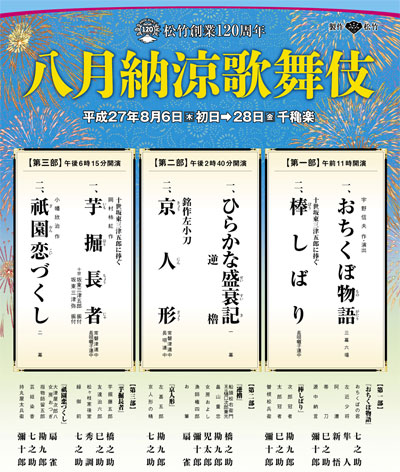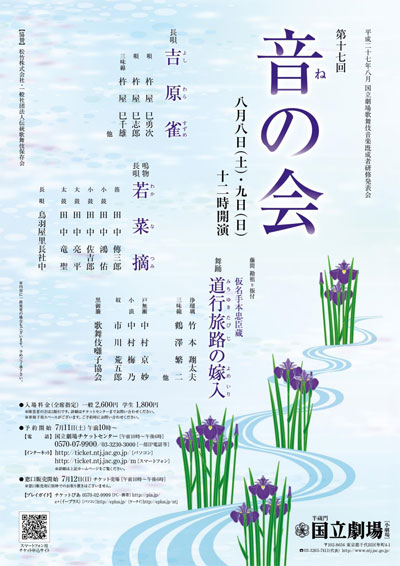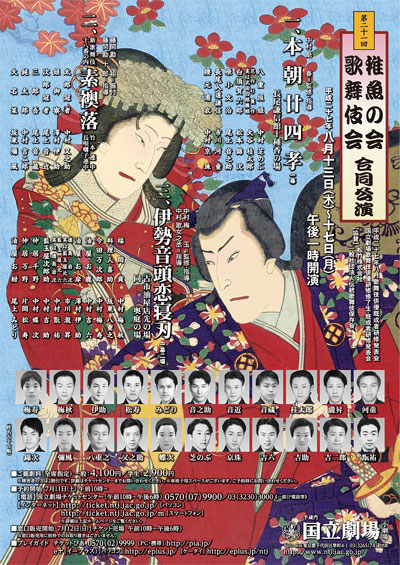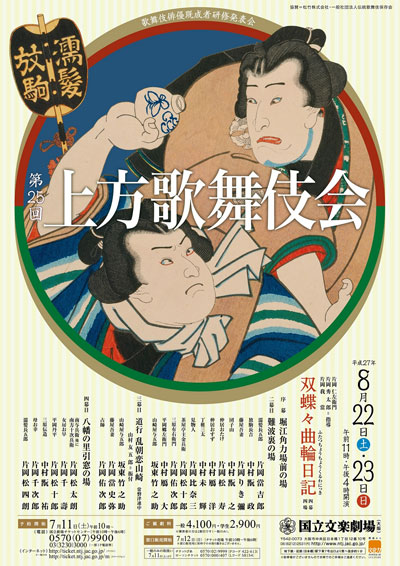| AUGUST 2015 |
|
7 shows in T˘ky˘ (Kabukiza, National Theatre), 1 show in Yokohama (Kanagawa Arts Theatre), 1 in Nagoya (Chűnichi Theatre), 5 in ďsaka (Shinkabukiza, Orix Theatre, National Bunraku Theatre, Kintetsu Art Kan) and 1 in Naruto (Ry˘zenji Temple)!
|
| Kabukiza (T˘ky˘) |  |
| Dates | 6 ~ 28 August 2015 (Hachigatsu N˘ry˘ Kabuki) August Cool-Breeze Kabuki |
| MatinÚe |
Ochikubo Monogatari |
| Afternoon | |
| Evening |
Gion Koi Zukushi |
| Casting |
Nakamura Kankur˘, Nakamura Shichinosuke, Nakamura Hashinosuke, Nakamura Senjaku, Band˘ Yajűr˘, Band˘ Shűch˘, Ichikawa Komaz˘, Band˘ Minosuke, Band˘ Shingo, Nakamura Hayato, Nakamura Kotar˘, Sawamura S˘nosuke, Nakamura Kamenoj˘, Nakamura Tsurumatsu, Nakamura Toranosuke, Nakamura Kunio, Nakamura Yoshio |
| Comments |
The usual summer program at the Kabukiza! It is entitled Hachigatsu N˘ry˘ Kabuki (literally "the August cool-breeze Kabuki").
|
 |
| Shinkabukiza (ďsaka) |
| Dates | 8 ~ 30 August 2015 (21 Seki Kabuki Gumi) The 21st Century Kabuki Group |
| Program |
Shin Suikoden |
| Casting |
Ichikawa Ukon, Ichikawa Emisabur˘, Ichikawa Emiya, Ichikawa En'ya, Ichikawa Shun'en, Ichikawa Juen, Ichikawa K˘tar˘, Kasahara Akira |
| Comments |
A special program by the 21 Seki Kabuki Gumi, which gathers the best actors of the Omodakaya guild. "Shin Suikoden" was staged for the first time in August 2008 at Le Theatre Ginza (T˘ky˘). It was staged in June 2011 at the Chűnichi Theatre (Nagoya) and in August 2013 at the ďsaka Shinkabukiza. The story is based on "Shin Suikoden", "New Tales from the Water Margin" in English, a novel written by Yoshikawa Eiji and published in Japan between 1960 and 1963. This novel was itself based on the famous Chinese novel "Water Margin" ("Shui Hu Zhuan" in Chinese). The story of this 14th century novel is set in the Song Dynasty and it tells of how a group of 108 outlaws gathers at Mount Liang to form a sizable army before they are eventually granted amnesty by the government and sent on campaigns to resist foreign invaders and suppress rebel forces. In 1805, Kyokutei Bakin released a Japanese translation of the "Water Margin" illustrated by Hokusai. The book, which was called "Shinpen Suikogaden", (the "New Illustrated Edition of the Suikoden"), was a success during the Edo period and spurred a Japanese "Suikoden" craze. |
|
|||
| Dates | 2 ~ 10 August 2015 (Roppongi Kabuki Nagoya K˘en) Roppongi Kabuki Nagoya Performances |
||
| Program | |||
| Casting |
Ichikawa Ebiz˘, Nakamura Shid˘, Kataoka Ichiz˘, Ichimura Manjir˘, Band˘ Kamesabur˘, Ichikawa Kudanji, Nakamura Kazutar˘, ďtani Hiromatsu, Ichimura Takematsu, Ichikawa Fukutar˘ |
||
| Comments |
Roppongi Kabuki in Nagoya! The script was written by Kud˘ Kankur˘, who already did "ďedo Ribingu Deddo" in 2009 [more details] and "Tennichib˘" in 2012 [more details]. The stage direction is done by the famous movie director Miike Takashi, an expert in violent and bizarre movies who worked twice with Ichikawa Ebiz˘ in the movies Hara-Kiri: Death of a Samurai (2011) and "Over your Dead Body" (2014). The story is about a space alien invasion of Earth. The invaders, coming from outter space, land in Edo during the Genroku period. The head of the extraterrestrial forces, Daashi Beidayű (phonetically, it is not so far from Darth Vader), is Nakamura Shid˘, the villain in this play. The savior of Planet Earth, Chikyű Nagegor˘ (Earth-Throwing Gor˘?) is Ichikawa Ebiz˘. The very first "Space Aragoto" in Japan in Kabuki history! The first Sci-Fi Kabuki drama was "The Emperor of Mars", which was staged at the University of Hawai'i in 1981. More details about "Chikyű Nagegor˘ Uchű no Aragoto" on the site of the Japan Times! |
||
|
|||
| Dates | 15 ~ 23 August 2015 (Roppongi Kabuki ďsaka K˘en) Roppongi Kabuki ďsaka Performances |
||
| Program | |||
| Casting |
Ichikawa Ebiz˘, Nakamura Shid˘, Kataoka Ichiz˘, Ichimura Manjir˘, Band˘ Kamesabur˘, Ichikawa Kudanji, Nakamura Kazutar˘, ďtani Hiromatsu, Ichimura Takematsu, Ichikawa Fukutar˘ |
||
| Comments |
Roppongi Kabuki in ďsaka! The script was written by Kud˘ Kankur˘, who already did "ďedo Ribingu Deddo" in 2009 [more details] and "Tennichib˘" in 2012 [more details]. The stage direction is done by the famous movie director Miike Takashi, an expert in violent and bizarre movies who worked twice with Ichikawa Ebiz˘ in the movies Hara-Kiri: Death of a Samurai (2011) and "Over your Dead Body" (2014). The story is about a space alien invasion of Earth. The invaders, coming from outter space, land in Edo during the Genroku period. The head of the extraterrestrial forces, Daashi Beidayű (phonetically, it is not so far from Darth Vader), is Nakamura Shid˘, the villain in this play. The savior of Planet Earth, Chikyű Nagegor˘ (Earth-Throwing Gor˘?) is Ichikawa Ebiz˘. The very first "Space Aragoto" in Japan in Kabuki history! The first Sci-Fi Kabuki drama was "The Emperor of Mars", which was staged at the University of Hawai'i in 1981. More details about "Chikyű Nagegor˘ Uchű no Aragoto" on the site of the Japan Times! |
||
| National Theatre (T˘ky˘) |
| Dates | 1 ~ 2 August 2015 (Matsuo-juku Kodomo Kabuki) Matsuo Academy of Kabuki ~ Kabuki for Kids Performance |
| Program |
Koi Ny˘b˘ Somewake Tazuna Oyako Jishi |
| Comments |
The Matsuo-juku Kodomo Kabuki [website in Japanese] is a kodomo shibai troupe, founded in ďsaka in 1988 by Matsuo Hazue, the wife of Matsuo Kuniz˘ (1899~1984), whose name is closely associated to the Matsuo Artistic Awards (Matsuo Gein˘ Sh˘). The troupe is now led by Matsuo Hazue's daughter Matsuo Hideko. The troupe celebrated its 25th anniversary in 2012. |
| Dates | 8 ~ 9 August 2015 (Ne no Kai) |
| Program |
Wakana Tsumi |
| Comments |
17th edition of the summer program of the association Ne no Kai (literally 'the Sound Association'). The two first items are music performances done by the Nagauta ensemble of the Onoe Kikugor˘ Gekidan. The last item is the dance drama "Michiyuki Tabiji no Yomeiri" performed by Kabuki actors. |
 |
| Dates | 13 ~ 17 August 2015 (Chigyokai/Kabukikai) |
| Program | |
| Comments |
21st edition of the common program for 2 associations, the Chigyokai (the Young Fishes Association) and the Kabukikai (the Kabuki Association), which stars stars' disciples in the leading roles of all the items in the program, with the guidance of Nakamura Kaishun ("Jusshuk˘") and Nakamura Baigyoku ("Ise Ondo"). |
 |
| Dates | 22 ~ 23 August 2015 (Ken no Kai) |
| Program | |
| Comments |
1st edition of the Ken no Kai, which stars Onoe Kikugor˘ VI's great-grandson Onoe Ukon. Ken no Kai literally means 'Ken's Association' with Ken being the first ideogram in Onoe Ukon's real first name Kensuke. Ichikawa Ennosuke is the guest star of this program.
|
| Dates | 24 ~ 25 August 2015 (S˘ch˘kai) |
| Program | |
| Comments |
1st edition of the S˘ch˘kai (literally "the Two Butterflies Association"), which stars Nakamura Kash˘ and his brother Nakamura Tanenosuke. Nakamura Shibajaku, Nakamura Matagor˘, Ichikawa Somegor˘ and Onoe Sh˘roku are the guest stars of this program.
|
 |
|
|||
| Dates | 8 August 2015 (IDOMU) Challenge |
||
| Program |
Futari Bakama |
||
| Casting | |||
| Comments |
A gala program called Idomu (Challenge) for the young actor Onoe Matsuya. Onoe Matsuya and his guest star Kataoka Takatar˘ plays the roles of Wankyű and his lover Matsuyama in "Ninin Wankyű". |
||
|
|||
| Dates | 31 July ~ 2 August 2015 (Sora no Kai) | ||
| Program |
Urashima Tanuki Ukiyo Banashi Hitoyo no Adauchi |
||
| Casting |
Kataoka Matsujűr˘, Kataoka Senjir˘, Kataoka Senju |
||
| Comments |
The 1st gala of the Sora no Kai (literally 'Sky Society'), in ďsaka at the Kintetsu Art Kan, which stars Kataoka Matsujűr˘, Kataoka Senjir˘ and Kataoka Senju, 3 disciples of the Matsushimaya guild. Sora no Kai literally means "Sky Association".
|
||
| National Bunraku Theatre (ďsaka) |
| Dates | 8 ~ 9 August 2015 (Matsuo-juku Kodomo Kabuki) Matsuo Academy of Kabuki ~ Kabuki for Kids Performance |
| Program |
Koi Ny˘b˘ Somewake Tazuna Oyako Jishi |
| Comments |
The Matsuo-juku Kodomo Kabuki [website in Japanese] is a kodomo shibai troupe, founded in ďsaka in 1988 by Matsuo Hazue, the wife of Matsuo Kuniz˘ (1899~1984), whose name is closely associated to the Matsuo Artistic Awards (Matsuo Gein˘ Sh˘). The troupe is now led by Matsuo Hazue's daughter Matsuo Hideko. The troupe celebrated its 25th anniversary in 2012. |
| Dates | 22 ~ 23 August 2015 (Kamigata Kabukikai) |
| Program |
|
| Comments |
25th edition of the Kamigata Kabukikai (the Kamigata Kabuki Association), a summer program in ďsaka which stars Kamigata Kabuki stars' disciples in the leading roles of all the items, with the guidance of Kataoka Nizaemon, Kataoka Gat˘ and Kataoka Hidetar˘. |
 |
| National N˘ Theatre (T˘ky˘) |
| Dates | 2 August 2015 (Sh˘ no Kai) |
| Program | |
| Comments |
2nd edition of the Sh˘ no Kai, a gala program which stars Nakamura Tomijűr˘ V's son Nakamura Takanosuke. Nakamura Takanosuke performs in both "Fuji Musume" and "Tamaya". His sister Watanabe Aiko performs in "Ame no Gor˘". The third item in this program is a maibayashi dedicated to the N˘ master Katayama Yűsetsu, who passed away the 13th of January 2015. Nakamura Takanosuke plays the role of Musashib˘ Benkei in "Ataka", which is in N˘ the root for the Kabuki dance-drama "Kanjinch˘". The jiutai is led by the N˘ master Katayama Kur˘emon X. |
| Ry˘zenji Temple (Naruto) | |
| Dates | Due to an injury, Ichikawa Danz˘ stopped acting from the 4th of July 2015 at the National Theatre. This program is postponed! |
| Program |
Taidan Keisei Awa no Naruto Kanjinch˘ |
| Casting | |
| Comments |
Ichikawa Danz˘ IX commemorate the 49th anniversary (50th memorial service) of the passing away of his grandfather Ichikawa Danz˘ VIII. He performs the longevity dance of Musashib˘ Benkei, a famous section from the dance-drama "Kanjinch˘", within the precincts of the Ry˘zenji temple in the city of Naruto in Tokushima Prefecture. These performances, which are called Ry˘zenji H˘n˘ Kabuki~Saraba Shikoku (Offering Kabuki at the Ry˘zenji Temple~Farewell Shikoku), will happen the 22nd and 23rd of August 2015 [more details about the passing away of Ichikawa Danz˘ VIII]. Taidan is a talk about Ichikawa Danz˘ VIII done by the long-time NHK announcer Kasai Seiji and Ichikawa Danz˘ IX. "Kuni Namari Futaba no Oizuru" is performed by a local troupe of kodomo shibai. |
|
|
| Contact | Main | Top | Updates | Actors | Plays | Playwrights | Programs | Links | FAQ | Glossary | Chronology | Illustrations | Prints | Characters | Derivatives | Theaters | Coming soon | News |


